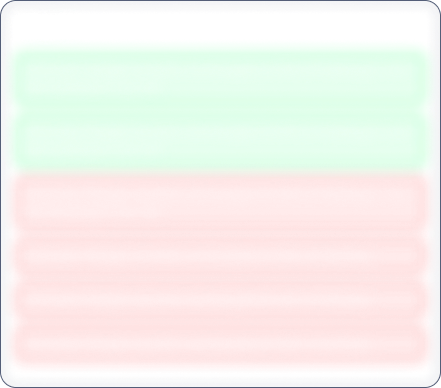Year End Sale 50% off
String Metaverse

No Data Available
Investor Sentiment
String Metaverse Share price and Fundamental Analysis
Key Metrics
Stock Returns
Stock Heatmap

No Stocks
Smart Score

Unlock Smart Score
See Detailed Analysis & Insights


Unlock Insights
See Detailed Analysis & Insights
Technicals
Returns Calculator
If you would have investedResearch Report
No Research Report
Corporate Action
Financials
Key Ratios
ROE
Avg ROE (3 Yrs) : NaN%
ROCE
Avg ROCE (3 Yrs) : NaN%
ROA
Avg ROA (3 Yrs) : NaN%
NPM
Avg NPM (3 Yrs) : NaN%
Dividend History
5 Year FactSheet
Documents

No Data Available
News
String Metaverse Management and History
Company Management


Unlock Management Data
See Detailed Analysis & Insights
Company History
Bio Green Papers Limited was incorporated on March 17th, 1994. The Company is into the business of Kraft Paper Production and Processing of Jatropha plants.
The Company has its facilities located at Akkurada Village, which is in 120 km distance from Visakhapatnam has ramped up the production capacities to the tune of 40 TPD (Tons Per Day) capacities of Kraft Paper Production and 40 TPD capacities of Duplex Board Facilities. The factory building and land are spread across 6.5 acres of land. Bio Green Papers possesses free-hold land of 50 acres in which currently the Company is undertaking plantation activities including bio-diesel.
The Kraft Paper produced by the Company is of 70 GSM to 180 GSM quality range and used to make corrugated boxes, paper tubes, cones, match boxes, shoe boxes and cosmetic containers. Manufacturing process of Kraft consists of the stages like Selection of Waste Paper, Pulping, Chemical Additives, Paper Making and Finishing & Storage. Pulp is the primary raw material used for manufacturing paper, and it can be obtained through processing of wastepaper. The Duplex Board has 150 to 600 GSM range and used for Gift Boxes, Shoes Boxes, Product and Food Packaging and Flat Files.
The Company selects planting material from the seeds that have proven, over several seasons, to have high yield and seed oil content under the same irrigation and fertilization conditions that are proposed for the new plantation. Seed from high-yielding Jatropha plants is not generally available, due to the fact that the out-crossing seed selected from productive plants may or may not result in high-yielding and high-quality plants. So, the company select trees capable of producing more than 2 tonnes of dry seed per ha with 30 percent seed oil content should be selected as source material.
String Metaverse Share Price
String Metaverse share price reflects investor sentiment toward the company and is impacted by various factors such as financial performance, market trends, and economic conditions. Share price is an indicator which shows the current value of the company's shares at which buyers or sellers can transact.
String Metaverse Market Cap
Market capitalization of String Metaverse indicates the total value of its outstanding shares. Marketcap is calculated by multiplying share price and outstanding shares of the company. It is a helpful metric for assessing the company's size and market Valuation. It also helps investors understand how String Metaverse is valued compared to its competitors.
String Metaverse PE Ratio
String Metaverse PE ratio helps investors understand what is the market value of each stock compared to String Metaverse 's earnings. A PE ratio higher than the average industry PE could indicate an overvaluation of the stock, whereas a lower PE compared to the average industry PE could indicate an undervaluation.
String Metaverse PEG Ratio
The PEG ratio of String Metaverse evaluates its PE ratio in relation to its growth rate. A PEG ratio of 1 indicates a fair value, a PEG ratio of less than 1 indicates undervaluation, and a PEG ratio of more than 1 indicates overvaluation.
String Metaverse ROE (Return on Equity)
Return on Equity (ROE) measures how effectively String Metaverse generates profit from shareholders' equity. A higher ROE of more than 20% indicates better financial performance in terms of profitability.
String Metaverse ROCE (Return on Capital Employed)
Return on Capital Employed (ROCE) evaluates the profitability of String Metaverse in relation to its capital employed. In simple terms, ROCE provides insight to investors as to how well the company is utilizing the capital deployed. A high ROCE of more than 20% shows that the business is making profitable use of its capital.
String Metaverse Total Debt
Total debt of String Metaverse shows how much the company owes to either banks or individual creditors. In simple terms, this is the amount the company has to repay. Total debt can be a very useful metric to show the financial health of the company. Total debt more than equity is considered to be a bad sign.
String Metaverse Debt to Equity Ratio
The Debt-to-Equity (DE) ratio of String Metaverse compares its total debt to shareholders' equity. A higher Debt to Equity ratio could indicate higher financial risk, while a lower ratio suggests that the company is managing its debt efficiently.
String Metaverse CAGR (Compound Annual Growth Rate)
CAGR shows the consistent growth rate of String Metaverse over a specific period, whether it is over a month, a year, or 10 years. It is a key metric to evaluate the company’s long-term growth potential. Main metrics for which CAGR is calculated are net sales, net profit, operating profit, and stock returns.
String Metaverse Technical Analysis
Technical analysis of String Metaverse helps investors get an insight into when they can enter or exit the stock. Key components of String Metaverse Technical Analysis include:
Support Levels (S1, S2, S3)
There are usually multiple support levels, but the main support levels for a stock are S1, S2, S3. Support levels indicate price points where stock might get support from buyers, helping the stock stop falling and rise.
Resistance Levels (R1, R2, R3)
There are usually multiple resistance levels, but the main resistance levels for a stock are R1, R2, R3. Resistance levels represent price points where String Metaverse shares often struggle to rise above due to selling pressure.
String Metaverse Dividends
Dividends refer to the portion of the company’s profits distributed to its shareholders. Dividends are typically paid out in cash and reflect String Metaverse ’s financial health and profitability.
String Metaverse Bonus Shares
Bonus shares are usually given by companies to make the stock more affordable, increase liquidity, boost investor confidence, and more.
String Metaverse Stock Split
Stock split increases the number of its outstanding shares by dividing each existing share into multiple shares. When the company offers a stock split, the face value of the stock reduces in the same proportion as the split ratio.
String Metaverse Financials
The financials of String Metaverse provide a complete view to investors about its net sales, net profit, operating profits, expenses, and overall financial health. Investors can analyze financial data to assess the company’s stability and also understand how the company has been growing financially.
String Metaverse Profit and Loss Statements
The profit and loss statement of String Metaverse highlights its net sales, net profit, total expenditure, and operating profits in the current financial year. This Profit and Loss statement is crucial for evaluating the profitability and financial stability of String Metaverse .
String Metaverse Balance Sheet
The balance sheet presents a snapshot of String Metaverse ’s assets, liabilities, and equity of shareholders, providing insights into the financials of the company.
String Metaverse Cashflow Statements
Cashflow statements track the company's cash inflows and outflows over a period. It is an essential tool for understanding how well the company manages its liquidity and finances.


